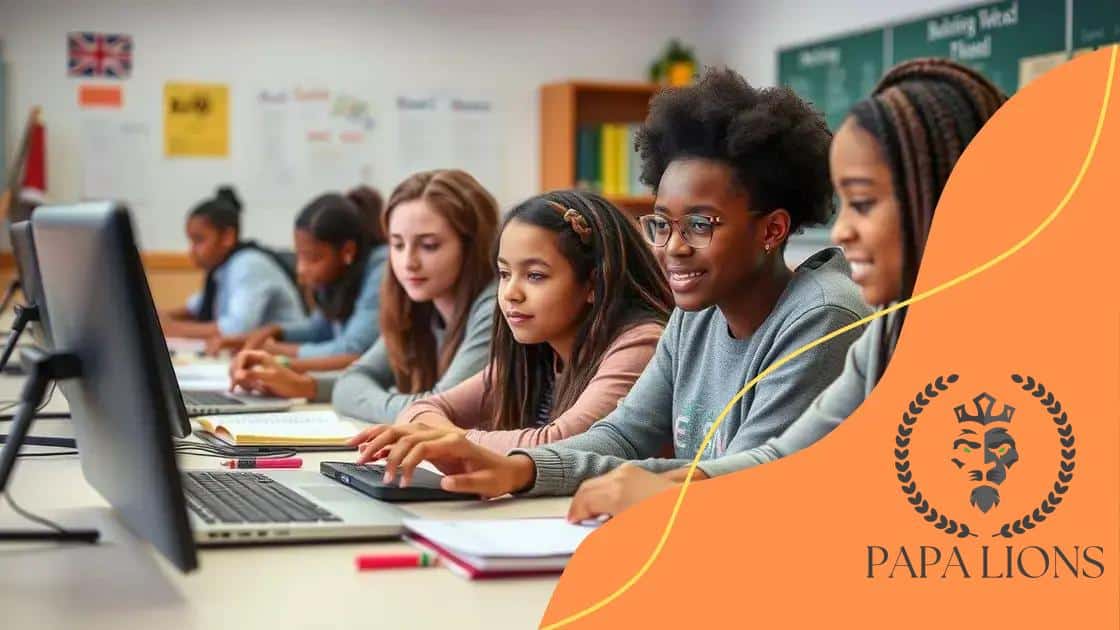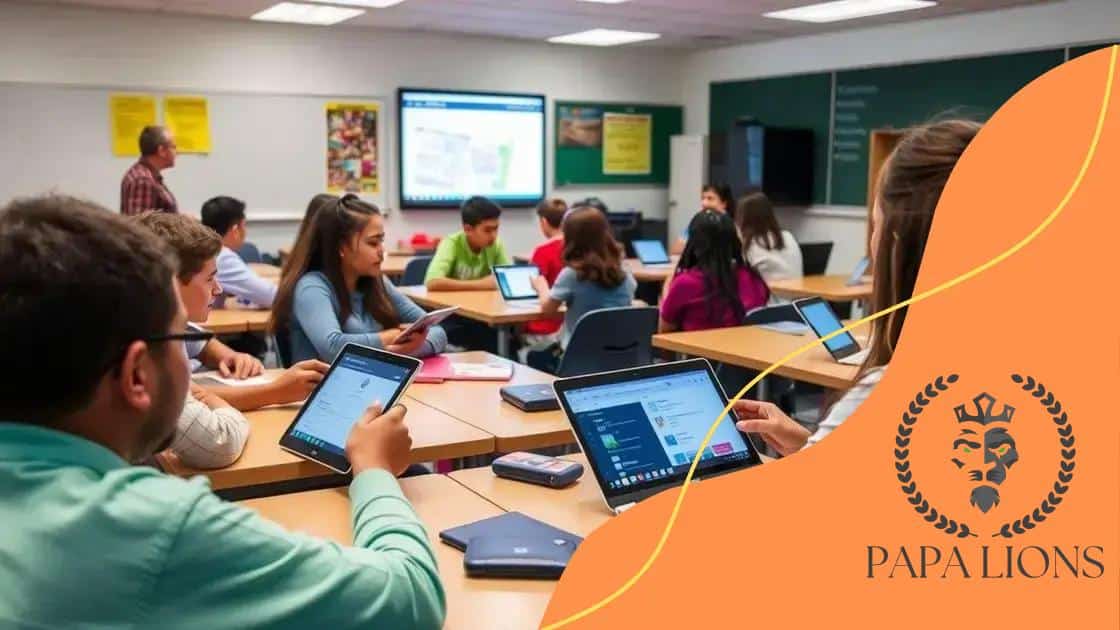Hybrid learning effectiveness: unlock your potential

Hybrid learning effectiveness combines the benefits of in-person and online education, enhancing flexibility, engagement, and personalized learning experiences for students while addressing the challenges of technology access and self-motivation.
Hybrid learning effectiveness is changing how we approach education today. Have you ever considered how blending online and in-person classes could enhance your learning experience? Let’s dive into its benefits and strategies!
Understanding hybrid learning: an overview
Understanding hybrid learning is crucial in today’s educational landscape. This approach combines traditional face-to-face instruction with online learning, creating a flexible and engaging environment for students.
Hybrid learning can enhance the educational experience by catering to different learning styles. In this model, students can benefit from interactive online resources while still enjoying the personal interaction that comes with in-person classes.
Benefits of Hybrid Learning
There are several reasons why hybrid learning is becoming more popular:
- Flexibility: Students can choose when and where to study.
- Personalized Learning: Learners can progress at their own pace.
- Access to Resources: A variety of online tools and materials are available.
- Increased Engagement: Blending different learning methods keeps students interested.
With these advantages, it’s clear why many institutions are adopting this strategy. Teachers can create more dynamic lessons, using technology to enhance their teaching methods.
However, making hybrid learning effective requires careful planning. Educators need to ensure that all students have access to necessary technology. This means providing support for students who may not have reliable internet connections or devices at home.
Additionally, instructors must develop skills in both online and offline teaching methods. Training can help teachers feel more comfortable using digital tools, allowing them to offer better support for all learners.
Challenges of Hybrid Learning
Even though hybrid learning has many benefits, there are challenges that need addressing:
- Technology Gaps: Not all students have equal access to technology.
- Self-Motivation: Some students may struggle to stay focused in a less structured environment.
- Teacher Training: Educators need ongoing support to master both formats.
By recognizing these challenges, schools can develop strategies to support students and teachers alike, ensuring that hybrid learning is effective for everyone.
Benefits of hybrid learning for students
The benefits of hybrid learning for students are numerous and significant. With this model, learners can combine the advantages of in-person interactions and online flexibility, leading to a more enriching educational experience.
One major benefit is personalized learning. Students can learn at their own pace, reviewing materials online at their convenience and benefiting from face-to-face guidance when needed. This flexibility allows them to grasp concepts more thoroughly, resulting in better academic performance.
Engagement and Motivation
Another important aspect is the increased engagement in learning. Hybrid learning often utilizes various multimedia resources and interactive tools that can enhance student interest. Engaging content keeps learners motivated and helps them stay focused on their studies.
- Variety of Learning Methods: Different approaches accommodate various learning styles.
- Real-World Skills: Utilizing technology prepares students for future workplace demands.
- Collaboration Opportunities: Students can work together using online platforms.
Furthermore, hybrid learning promotes collaboration among students. They can participate in group projects online, allowing for teamwork that transcends geographic barriers. This exposure fosters communication and collaboration skills that are essential in today’s world.
Moreover, the flexibility of hybrid learning allows students to balance academics with other responsibilities. Whether they are involved in extracurricular activities, part-time jobs, or family obligations, students can manage their time more effectively, leading to lower stress levels and better overall well-being.
Access to Resources
Students also gain access to a wealth of online resources. This includes extensive libraries, educational videos, and tutorials that can enhance their understanding of course materials. With a few clicks, they can find additional information that supports their learning, making the educational journey more comprehensive.
In summary, the hybrid learning model creates a supportive environment where students can thrive academically. It empowers them with the tools they need to succeed, making education more accessible and engaging.
Strategies for effective hybrid learning

To ensure effective hybrid learning, teachers and students must adopt specific strategies that maximize the benefits of both in-person and online education. By integrating these strategies, learners can engage more deeply with the material and develop important skills.
One key strategy is to create a structured schedule. A clear timetable helps students manage their time effectively and ensures they can balance both online and classroom activities. Regular check-ins can also keep students on track and provide opportunities for feedback.
Utilizing Technology
Another vital component is the use of technology. Educators should incorporate various digital tools to complement traditional teaching methods. This can include:
- Learning Management Systems: Platforms like Google Classroom or Moodle organize course materials and assignments.
- Interactive Tools: Tools such as Kahoot and Padlet encourage student participation and understanding.
- Video Conferencing: Programs like Zoom or Microsoft Teams support real-time discussions and collaboration.
By leveraging these resources, teachers can create an engaging learning environment that fosters collaboration and supports diverse learning styles.
Effective communication is also essential in hybrid learning. Instructors should encourage students to ask questions and participate in discussions, whether online or in person. This engagement helps build a sense of community among students and ensures that they feel connected to their peers and instructors, even in a blended setting.
Assessment and Feedback
Regular assessment and constructive feedback are crucial to the hybrid learning experience. Teachers should provide students with a mix of formative and summative assessments to gauge their understanding continually. Feedback should be timely and specific, allowing students to improve and adjust their study habits as necessary.
Creating opportunities for peer review can also enhance learning. Students can benefit from reviewing each other’s work, which encourages collaboration and critical thinking. These strategies not only deepen understanding but also prepare students for future challenges.
Incorporating social-emotional learning (SEL) practices is another way to make hybrid learning successful. Educators can implement SEL programs that teach skills such as empathy, resilience, and teamwork. These skills are crucial for students both in their educational journey and in life beyond the classroom.
Challenges of hybrid learning and solutions
Despite its many benefits, hybrid learning also presents unique challenges that can affect both students and educators. Understanding these challenges is essential for creating effective solutions that enhance the educational experience.
One of the primary issues is technology access. Not all students have reliable internet connections or devices suitable for online learning. This digital divide can lead to significant gaps in knowledge and participation, making it difficult for some students to keep up with their peers.
Identifying Key Challenges
Another challenge is the need for self-discipline. In a hybrid learning environment, students may struggle with motivation and time management. This is especially true for younger learners who are used to more structured classroom settings. Without the constant presence of an instructor, it’s easy to lose focus.
- Distractions at Home: Many students face interruptions and distractions that hinder their learning.
- Limited Interaction: Some students may feel isolated without enough face-to-face contact.
- Technical Issues: Software glitches or connectivity problems can disrupt lessons.
Additionally, educators may feel unprepared to effectively teach in a hybrid format. They need to master both in-person and online teaching methods, which can be overwhelming. Professional development and support are crucial for teachers to build confidence and skills.
Finding Solutions
To address these challenges, schools can implement several effective strategies. Providing students with necessary technology and access to reliable internet is essential. Schools can offer loaner devices and work with local internet providers to ensure connectivity for all students.
Creating structured schedules can help students manage their time better. Regular check-ins and support groups can provide the guidance many students need to stay engaged. Incorporating interactive elements in online lessons can also capture their interest and keep motivation high.
Professional development programs for teachers are equally important. Training that focuses on hybrid teaching techniques can empower educators with the skills they need to succeed. Moreover, fostering open communication among students, teachers, and families helps create a supportive environment conducive to learning.
Future trends in hybrid learning
As the landscape of education evolves, understanding the future trends in hybrid learning is essential. These trends not only reflect changes in technology but also shifts in teaching approaches and student needs.
One significant trend is the increasing integration of artificial intelligence (AI) in learning environments. AI can provide personalized learning experiences, adapting content to fit each student’s pace and proficiency. Tools using AI can analyze how students interact with materials, offering insights to help educators tailor their teaching strategies.
Growth of Online Resources
Another trend is the growth of online resources. Learning management systems are becoming more sophisticated, allowing seamless integration of various educational tools. Students can easily access a variety of materials, including videos, interactive quizzes, and virtual simulations, enhancing engagement and comprehension.
- Virtual Reality (VR): More schools are exploring VR to create immersive learning experiences.
- Gamification: Incorporating game elements into lessons can make learning more enjoyable and effective.
- Collaborative Platforms: Technology that supports group work can help students develop teamwork skills from anywhere.
Additionally, there is a shift towards a more student-centered approach in hybrid learning. This means focusing on student interests and experiences. Educators are encouraged to create lessons that are relevant and engaging, allowing students to take an active role in their learning journey.
Professional development for teachers will also continue to evolve. Ongoing training in the latest technologies and teaching methodologies will be crucial for maintaining effectiveness in hybrid environments. Teachers must be equipped to navigate and implement new tools effectively.
Focus on Social-Emotional Learning
Moreover, there will be a growing emphasis on social-emotional learning (SEL). As schools adopt hybrid models, supporting students’ emotional well-being will be vital. Programs that teach skills like resilience, empathy, and effective communication will become integral to the curriculum.
Recognizing the importance of mental health, schools will need to provide resources and support systems for students. This holistic approach fosters a more inclusive environment that promotes not just academic success but overall well-being.
FAQ – Frequently Asked Questions about Hybrid Learning
What are the benefits of hybrid learning for students?
Hybrid learning offers flexibility and personalized learning experiences, allowing students to study at their own pace and access diverse resources.
How can technology enhance hybrid learning?
Technology facilitates interactive tools, online resources, and communication platforms, making learning more engaging and accessible.
What challenges might students face in hybrid learning environments?
Students may struggle with technology access, motivation, and distractions at home, which can impact their learning experience.
What strategies can teachers use to improve hybrid learning?
Teachers can implement structured schedules, utilize diverse educational tools, and focus on social-emotional learning to support students effectively.





